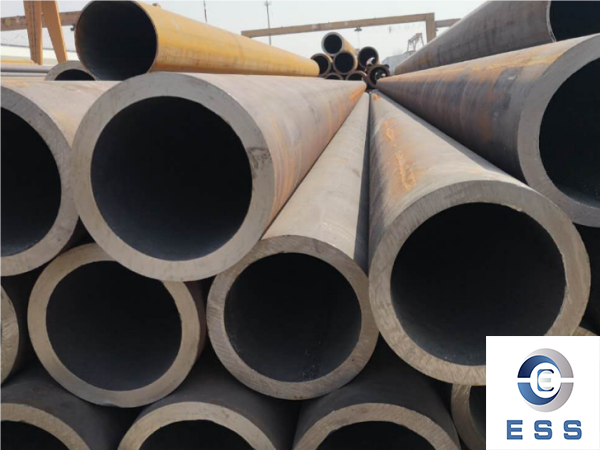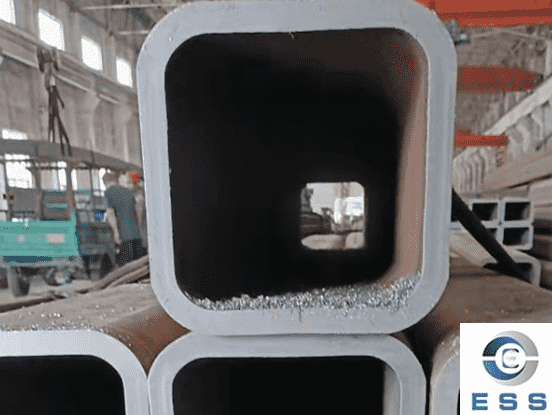Acceptance standards for large diameter steel pipes
Large-diameter steel pipes (such as spiral welded pipes) are pipe products mainly used to transport liquids, gases, solids and other substances, and are usually made of steel. These pipes are commonly used in construction, petrochemical, industry, water supply, heating and other fields. The following is some relevant information about large diameter welded pipes:

1. Large diameter welded pipe size
The size of large diameter welded pipes usually refers to steel welded pipes with larger diameters. Generally speaking, the size of large diameter welded pipes will vary according to production standards and requirements. The size of large-diameter welded pipes can include diameters from 6 inches to 60 inches, wall thickness is usually 5 mm to 30 mm, and the length can be customized according to customer needs, usually 6 meters, 9 meters or 12 meters, etc. This is just an example, actual dimensions will vary based on production standards, material requirements and usage. The specific size you need can be determined based on your project and needs.
2. Large diameter welded pipe material
Large diameter welded pipe can often be made from a variety of materials. Common materials include:
(1) Carbon steel: suitable for general industrial purposes and has good mechanical properties and welding properties.
(2) Alloy steel: It has the characteristics of high temperature resistance and corrosion resistance, and is suitable for high temperature and high pressure environments or the needs of special chemical industries.
(3) Stainless steel: corrosion-resistant, suitable for occasions with high requirements on material purity and surface.
(4) Other special materials: such as titanium alloy, nickel-based alloy, etc., suitable for special process requirements or special medium transportation.
Selecting the appropriate material depends on factors such as the specific use of the large diameter welded pipe, working environment, medium characteristics, and budget.
3. Manufacturing process of large diameter welded pipe
Different manufacturing processes are suitable for different pipe sizes, materials and usage requirements. Selecting the appropriate manufacturing process ensures the quality, performance and serviceability of welded pipe. Large diameter welded pipes usually use the following manufacturing processes:
(1) Straight seam welded pipe (LSAW steel pipe): This process is to roll the steel plate into a tube shape, and then use the welding process to weld the long seam on the edge of the tube plate. This process is suitable for the production of large-diameter, thick-walled welded pipes, which are often used in pipeline systems for transporting liquids and gases.
(2) Spiral welded pipe (SSAW steel pipe): This process is to roll the steel plate into a tube shape through a plate rolling machine, and then weld it through a continuous spiral welding process. Spiral welded pipes are suitable for pipes with larger diameters and thicker walls, and are mainly used to transport oil, natural gas or other media.
(3) Drawing method: Large-diameter thin-walled welded pipes are made by drawing steel billets. This process is suitable for occasions that require high surface quality and dimensional accuracy of pipes.
(4) Cold drawing method: After heating the steel billet to an appropriate temperature, the welded pipe is made by cold drawing process. This process is suitable for producing welded pipes with thin wall thickness and high dimensional accuracy requirements.
4. Large diameter welded pipe standards
The production and quality of large-diameter welded pipes generally need to comply with the following international standards and industry standards:
(1) ASTM standards: The American Society for Testing and Materials has developed a number of welded pipe standards, such as ASTMA53/A53M, ASTMA252, ASTMA139, etc., covering the requirements and uses of welded pipes of different materials and materials. size.
(2) API standards: The American Petroleum Institute has promulgated a series of oil and gas industry standards, including standards for welded pipes and seamless pipes, such as API5L.
(3) DIN standards: The German Standardization Organization has promulgated a number of steel pipe standards, such as DIN2458, DIN1626, etc.
(4) GB standards: China National Standardization Administration Committee has promulgated a series of national standards for welded pipes, such as GB/T3091, GB/T9711, etc.
These standards cover the material, size, manufacturing process, inspection requirements, etc. of welded pipes, ensuring the quality and safety of welded pipe products. In actual procurement and use, standard products that meet the requirements should be selected based on specific project needs and relevant national/regional regulations and standards. So let’s take a look at the standards for accepting welded steel pipes.
Acceptance standards for welded pipes
Steel pipe welding is a commonly used process in construction, machinery manufacturing, oil, natural gas, hydropower, chemical and other industries, but the quality of welded steel pipes directly affects the safety and service life of the project. Therefore, the quality of steel pipe welding must undergo strict acceptance. The following is a detailed introduction to the acceptance standards and acceptance methods of welded pipes.
1. Acceptance standards for welded pipes
(1)Weld seam forming
The weld seam should be uniform and continuous, without gaps and black slag inclusions. Both sides of the weld should be straight and smooth, without obvious unevenness, inclusions, subsurface cracks and other defects.
(2)Weld appearance
Welded steel pipes should ensure complete penetration of the weld, and there should be no missing welds, weak welds, local poor fusion, etc.
(3)Dimensional deviation
When inspecting welded steel pipes, it should be noted that basic deviations such as pipe diameter, wall thickness, tolerances, and curvature should comply with the requirements of engineering specifications.
(4)Chemical composition
Carry out chemical composition analysis and testing, and the steel pipe weld material should comply with the chemical composition specifications of steel.
(5)Mechanical properties
The mechanical properties of welded steel pipes should meet the requirements of national or industry standards. Steel pipe welds should be tested for tensile strength, bending strength and hardness values, and the results should be checked.
2. Acceptance method of welded pipes
(1) Appearance inspection
Conduct a comprehensive observation and inspection of the weld structure to see whether the direction and size of the weld meet the requirements of the engineering specifications. If there are irregular welds, sandblasting, chemical cleaning, etc. can be used to remove the welds.
(2) Non-destructive testing
Non-destructive testing refers to the use of heat, sound, light, electricity, magnetism and other methods to inspect the inside of mechanical materials without damaging or affecting the performance of the object being inspected. Does not damage the internal tissue of the object being measured. and other reaction changes, using physical or chemical methods as a means, and with the help of modern technology and equipment, to analyze the structure and state of the interior and surface of the specimen, as well as its type, quantity, shape, nature, location, size, distribution and changes of defects. Methods for conducting inspections and tests. High-precision non-destructive testing technologies such as ultrasonic testing, X-ray testing or magnetic particle testing are used to detect possible defects in the welds. Once discovered, it needs to be corrected promptly.
(3) Mechanical parameter detection
Standardized testing equipment is used to measure the mechanical properties of electric welded steel pipes from multiple angles to determine whether they meet engineering requirements and standards. Commonly used mechanical property indicators include: strength, plasticity, hardness, impact toughness, fatigue strength, etc.













 Eastern Steel Manufacturing Co.,Ltd not only improve product production and sales services, but also provide additional value-added services. As long as you need, we can complete your specific needs together.
Eastern Steel Manufacturing Co.,Ltd not only improve product production and sales services, but also provide additional value-added services. As long as you need, we can complete your specific needs together.










